Modern Service Industry
Big Health Industry Park Project of Baishan City
1. Introduction to the Project
1.1 Project background
1.1.1 Product introduction
The project relies on the unique high-quality green ecological resource advantages of Baishan City, such as the “three-dimensional resource treasure trove”, “Changbai forest sea”, and “ginseng hometown” of Changbai Mountain, with the goal of promoting industrial integration, rural revitalization, and economic revitalization in the region. It is supported by the “5G+” big health industry, assisted by the smart cold chain logistics industry, firmly committed to regional development as the foundation, innovative as the means, and market-oriented, comprehensively utilizing regional land, space, and original ecological high-quality agricultural product resources to create Baishan City’s first diversified, ecological, and intelligent big health industry innovation demonstration park. After 5-10 years of efforts, this project will be built into a “national level big health industry demonstration zone” and “Changbai Mountain Original Ecological Characteristic Industry-University-Research Integration Demonstration Base” and “National Rural Revitalization Model Demonstration Zone”.
The total land area of the project is approximately 550000 square meters, and it will be constructed in stages around two major sectors: the big health industry and smart cold chain logistics.
1.1.2 Market prospect
(1) Analysis of the current situation of the big health industry
The health industry is a special sunrise industry that is related to the national economy and people’s livelihood. Its coverage is wide and the industrial chain is long, directly affecting the development of multiple industries in the national economy; developing the health industry is undoubtedly an important direction for promoting economic structural adjustment and supply side structural reform. The concept of the big health industry is mainly based on people’s various needs for health, including physical, mental, and environmental aspects. The various requirements and development status of these aspects constitute the core content of the industry, covering multiple dimensions such as medicine, medical care, health products, health food, rehabilitation and elderly care. It is a very large and complex industrial field. In this field, it involves multiple sub fields such as healthcare, supplies, food, equipment, appliances, health management, and consulting.
In recent years, multiple departments including the National Development and Reform Commission, the Ministry of Finance, the State Council, the National Health Commission, and the Drug Administration have successively issued policies to standardize, support, and plan the development of the big health industry. The Report of the 19th National Congress of the Communist Party of China proposed the “Implementation of the Healthy China Strategy”, which is a major strategic deployment of the Party Central Committee with President Xi Jinping as the core to adhere to and develop socialism with Chinese characteristics in the new era from the perspective of long-term development and the forefront of the times. Firmly implementing this strategy, promoting the development of the healthcare industry and the continuous improvement of people's health levels will undoubtedly lay a solid foundation for winning the bid to build a moderately prosperous society in all respects and a socialist modernized strong country. The modern concept of the big health industry is no longer simply the pharmaceutical and medical industry. Any related industry that directly or indirectly affects human health belongs to the category of the big health industry.
In March, 2023, the General Office of the Communist Party of China Central Committee and the General Office of the State Council issued the Opinions on Further Improving the Medical and Health Service System, proposing that by 2025, the medical and health service system will have been further improved, resource allocation and service balance will have gradually improved, major disease prevention and control, rescue and emergency response capabilities will have been significantly enhanced, the development of traditional Chinese and Western medicine will have been more coordinated, and the construction of orderly medical treatment and diagnosis and treatment systems will have achieved positive results. In January, 2024, the General Office of the Ministry of Education issued the Guiding Professional Guidelines for Talent Training in the Service of Health and Health Industry, proposing to focus on the strategy of serving China’s health and building a strong education country, facing the forefront of world science and technology, the main battlefield of the economy, major national needs, and people’s health, guiding universities to accelerate the layout and construction of a number of adaptive and leading new medical majors, accelerate the cultivation of urgently needed and scarce composite talents, better serve the development of the health industry and health industry, and provide strong support for maintaining public health.
The upstream of the big health industry chain consists of product and equipment research and development manufacturing industries, mainly including medical research and development outsourcing, drug manufacturing, medical device and consumables manufacturing, health product manufacturing, and health equipment manufacturing; the midstream of the big health industry chain is composed of medical business and health service industry, among which, medical business includes medical circulation, medical retail, medical wholesale, medical storage, etc., and health service industry includes medical industry, health management service industry, pension service industry, health culture, health tourism, health sports, health real estate, medical beauty industry, Internet medicine, medical informatization, health insurance and other industries; the downstream of the big health industry chain mainly includes medical institutions, doctors, and consumers (patients).
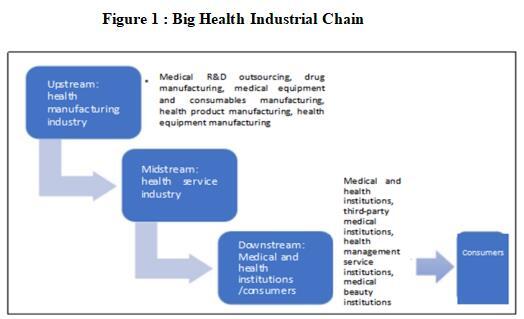
By now, the big health industry has become a powerful driving force for economic growth in developed countries; In China, the big health industry has just started, but there is huge room for future growth. The important prerequisite for the development of the big health industry is to transform the traditional medical industry development model, that is, to shift from a single treatment model to an integrated prevention and treatment maintenance model. To this end, in addition to continuing to develop the medical and pharmaceutical industry mainly based on medical devices and drugs, we should also accelerate the development of the health product industry mainly based on health food, cosmetics, functional daily necessities, etc., and the health management service industry mainly based on personalized health testing and evaluation, consulting services, disease rehabilitation, etc.
In recent years, the number of medical device manufacturing enterprises in China has been on the rise. By the end of 2023, there have been approximately 36700 medical device manufacturing enterprises in China, a year-on-year increase of 8.58%.
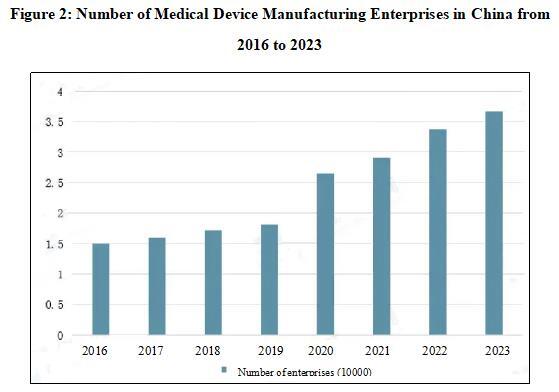
According to data from the National Health Commission, the overall number of medical and health institutions in China has remained stable with an upward trend from 2018 to 2023, rising to 1.071 million in 2023.
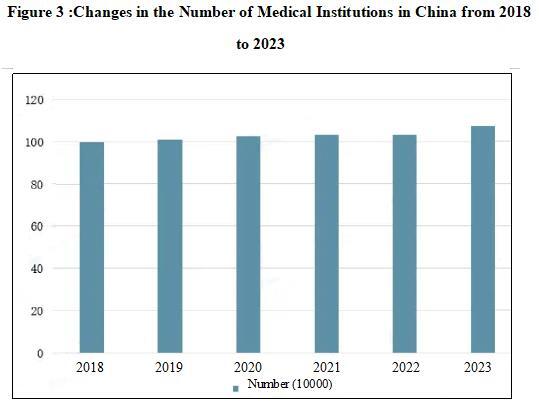
At present, China’s big health industry is showing a vigorous development trend. According to statistics, by 2023, the size of China’s big health market has grown to 7712.7 billion yuan, including 884.8 billion yuan for the medical service industry, 2945.3 billion yuan for the medical industry, 414.5 billion yuan for the health product industry, 332.4 billion yuan for health management services, and 3135.7 billion yuan for health and elderly care.
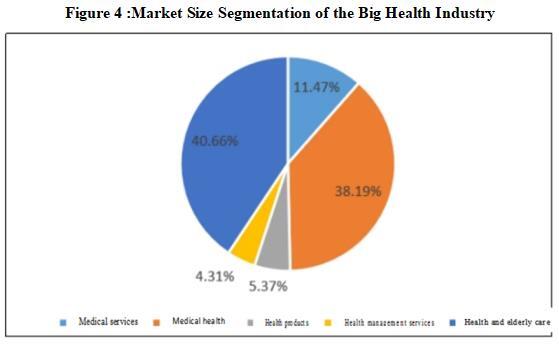
At present, China’s big health industry is showing a vigorous development trend. According to statistics, by 2023, the size of China’s big health market has grown to 7712.7 billion yuan, including 884.8 billion yuan for the medical service industry, 2945.3 billion yuan for the medical industry, 414.5 billion yuan for the health product industry, 332.4 billion yuan for health management services, 3135.7 billion yuan for health care and elderly care, and 7712.7 billion yuan for the big health market.

With the deepening of population aging in China, health and elderly care has become an important part of the general health industry. From the perspective of the proportion of segmented products in China’s overall health industry in 2023, the proportion of health and elderly care products exceeded 40%. Next was the pharmaceutical industry, accounting for 38.19%. At present, the field of health and elderly care is gradually developing towards intelligence, specialization, and comprehensiveness to meet the diverse health needs of the elderly. In the future, with policy support and technological advancements, the proportion of health and elderly care in the overall health market is expected to further expand.
(2) Market prospect of industrial parks
At present, there are 696 national level industrial parks in China; among them, there are 230 national economic development zones, 178 high-tech zones, 171 customs special supervision zones, 19 border/cross-border cooperation zones, 22 national free trade pilot zones, 19 national new zones, 23 national independent innovation demonstration zones, and 25 other national industrial parks. Provincial-level industrial parks are approved by the governments of provinces, autonomous regions, and municipalities directly under the central government, with a current total of 2133. In addition, the city and county governments in China also have jurisdiction over tens of thousands of grassroots industrial parks, including general industrial parks, agricultural parks, etc.
In 2023, there were a total of 54 industrial parks with a gross domestic product exceeding 100 billion yuan, an increase of 6 compared to the previous year. 67 industrial parks with over 300 high-tech enterprises, an increase of 2 from the previous year, and 49 industrial parks with import and export volumes exceeding 50 billion yuan, an increase of 9 from the previous year. Meanwhile, among the top 100 industrial parks in 2023, there were a total of 52 high-tech zones and 48 economic development zones. Among the top 30, there were 17 high-tech zones and economic 13 development zones account, indicating that high-tech zones have obvious advantages. Among the bottom 30, there were 18 economic development zones, 12 mew and high-tech zones, and the economic development zones have a relatively large proportion.
Excellent industrial parks have a complete industrial ecosystem and the ability for industrial aggregation and development. They provide competitive enterprise supporting services and related facilities, providing convenient office environments and good industrial collaboration mechanisms for enterprises.
Through industrial clustering, park enterprises can form industrial clusters, cooperate with each other, share resources, promote technological innovation and knowledge sharing. By establishing a complete industrial ecosystem, industrial parks can attract more investment and enterprises to settle in, promoting local economic prosperity and enhancing innovation capabilities.
1.1.3 Technical analysis
This project has employed an internationally renowned team to provide professional design for the project’s planning layout, business format setting, functional positioning, etc., laying the foundation for the project’s vitality from the early design stage.
1.1.4 Advantageous conditions of project construction
(1) Policy advantages
The Healthy China 2030 Plan Outline proposes that by 2030, the scale of China’s health industry will have significantly expanded, and the total scale of the health service industry will have reached 16 trillion yuan.
The 14th Five-Year Plan for National Health proposes that by 2025, the health system will have been more perfect, the basic medical and health system with Chinese characteristics will have gradually improved, the unique advantages of traditional Chinese medicine will have been further utilized, and the innovation capability of health technology will have been significantly enhanced; we should consolidate the foundation for high-quality development of traditional Chinese medicine. Promote technological innovation in traditional Chinese medicine. Encourage innovation and use of new drug research and development, accelerate the development and industrialization of drugs for the treatment of major diseases urgently needed in clinical practice, and support the development of high-quality generic drugs. Promote the manufacturing and production of high-end medical equipment and health products, focusing on the development of new health products such as health management, intelligent rehabilitation aids, scientific fitness, and traditional Chinese medicine health care, and promote the entry of qualified artificial intelligence products into clinical trials. Promote the development of intelligent service robots, implement rehabilitation aids, and promote the application of smart aging technology.
In 2023, the National Medical Products Administration issued the Guiding Opinions on Further Strengthening and Improving the Classification Management of Medical Devices, proposing to draw on international experience, optimize management systems, improve management systems, enhance support capabilities, improve quality and efficiency, and further enhance the scientific, legal, international, and modern level of medical device classification management. This will help promote high-quality development of the industry and better protect and promote public health.
In January, 2024, the General Office of the Ministry of Education issued the Guiding Professional Guidelines for Talent Training in the Service of the Health Cause and Health Industry, proposing to focus on the strategy of serving health in China and building an education powerhouse, facing the forefront of world science and technology, the main battlefield of the economy, and major national needs Facing the people’s life and health, we will guide universities to accelerate the layout and construction of a number of adaptive and leading new medical majors, accelerate the cultivation of urgently needed and scarce composite talents, better serve the development of the health industry and the health sector, and provide strong support for maintaining public health.
(2) Resource advantages
There are more than 350 species of wild animals in Baishan City, among which there are as many as 37 rare and exotic animals such as manchurian tigers, brown bears, red deer, lynxes, and fragrant deer that are protected by the state. There are over 2300 species of wild plants and more than 1500 species of economic plants in Baishan City, including more than 900 medicinal plants such as ginseng, lingzhi, Rhodiola rosea, ginseng, gastrodia elata, and evening primrose. There are also over 200 aromatic plants such as lilac, lily of the valley, nocturna, and magnolia. Green edible plants include over 200 species such as fungi, mountain celery, fern, osmanthus, pine seeds, and mushrooms. More than 100 types of metallic and non-metallic minerals, including coal, iron ore, quartz sand, silica, talc, diatomaceous earth, bentonite, gypsum, crystal pumice, volcanic slag, marble, kaolinite, agate, lead, zinc, copper, magnesium, gold, antimony, silver, phosphorus, etc., have been discovered in Baishan City, accounting for 73% of the mineral discoveries in Jilin Province.
(3) Talent advantages
Baishan City will transport over 10000 skilled talents and train more than 20000 individuals of various types for the society. The labor resource advantages are obvious, and the proportion of skilled workers is at a high level in the Northeast urban agglomeration. The labor force is in a dividend period, and the labor cost is relatively low. There is a large number of high-quality industrial workers who can meet the needs of various enterprises.
Hunjiang District has always attached great importance to cultural education, with a relatively high level of education per capita. Two vocational and technical schools and Changbai Mountain University in the region provide talent resources guarantee for the smooth implementation of the project.
(4) Location and transportation advantages
Baishan City is a prefecture level city under the jurisdiction of Jilin Province, located on the west side of Changbai Mountain, adjacent to Yanbian Korean Autonomous Prefecture to the east, Tonghua City to the west, Jilin City to the north, and facing the Democratic People’s Republic of Korea across the Yalu River to the south. It is situated in the hinterland of Changbai Mountain.
Hunjiang District has superior geographical conditions and continuously enhances its carrying capacity for development. It is 178 kilometers north of Changchun and 300 kilometers south of Shenyang. There are currently two highways directly connecting Changchun and Shenyang. In the future, a high-speed railway and a domestic civil airport will be planned to be built, forming a comprehensive transportation system that extends in all directions and creating a new channel for the hinterland of Northeast China to go to sea and pass the customs.
1.2 Contents and scale of project construction
1.2.1 Construction scale
This project covers an area of 550000 square meters and will be constructed in stages around two major sectors: the big health industry and smart cold chain logistics.
1.2.2 Construction contents
The total construction area of the project is 134000 square meters, mainly constructing a large health industry zone and a smart cold chain logistics zone.
(1) Big health industry zone: The main construction includes the food processing area, food additive area, bio-medical area, plant extraction raw material medicine area, functional food area (including special meals, special medical food, health food), scientific research and administrative service office area, and public supporting service facilities.
(2) Smart cold chain logistics zone: mainly constructing low-temperature warehouses, high-temperature warehouses, comprehensive office areas, and employee living areas.
1.3 Total investment of the project and capital raising
1.3.1 Total investment of the project
The total investment of the project is 1 billion yuan, including the construction investment of 959.1362 million yuan and current funds of 40.8638 million yuan.
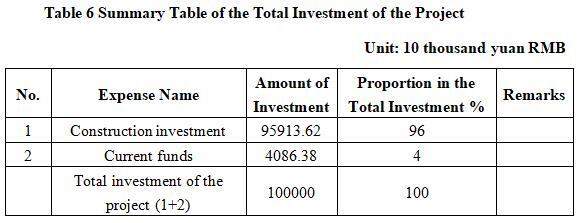
1.3.2 Capital raising
Self-raising by the enterprise
1.4 Financial analysis and social evaluation
1.4.1 Main financial indexes
After the project reaches the production capacity, its annual sales revenue will be 1.66667 billion yuan, its profit will be 208.33 million yuan, its investment payback period will be 8 years (after the tax, including the construction period of 2 years) and its return on investment will be 20.8%.
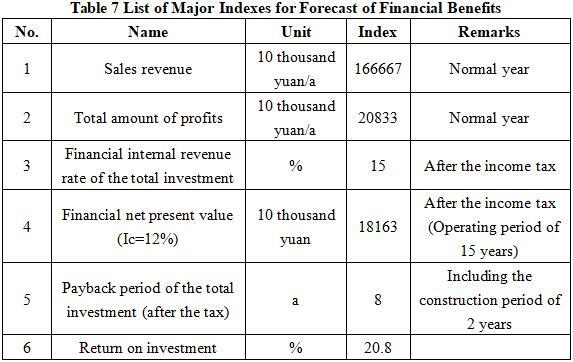
Note: “10 thousand yuan” in the table is in RMB.
1.4.2 Social evaluation
After the implementation of the project, it will promote the development of the big health industry in Jilin Province and promote industrial structural adjustment, which is in line with the health industry development policies proposed by the Party Central Committee and the State Council. It is also “integration” and “upgrading” of the existing industries in Baishan City, enriching the connotations of the big health industry, innovating the big health industry model, forming a brand advantage of characteristic health products, and actively promoting the development of the big health industry in Jilin Province and optimizing the industrial structure.
1.5 Cooperative way
Joint venture or cooperation, other methods can be discussed face-to-face.
1.6 What to be invested by the foreign party
Funds, and other methods can be discussed face-to-face.
1.7 Construction site of the project
Hunjiang District, Baishan City
1.8 Progress of the project
It is attracting foreign investment.
2. Introduction to the Partner
2.1 Basic information
Name: People’s Government of Hunjiang District
Address: 3666 Changbaishan Street, Baishan City
2.2 Overview
Hunjiang District of Baishan City is located in the southeast of Jilin Province, at the western foot of Changbai Mountain, on the north bank of the Yalu River, and facing the Democratic People’s Republic of Korea across the river to the southeast. Hunjiang District covers an area of 1388 square kilometers and has a total population of 349000. It is the political, economic, cultural, trade, financial, and information center of Baishan City. The hardworking and intelligent people of Hunjiang have innovated, striven for progress, and made the regional economic strength climb year after year. Hunjiang District is known as the “Hometown of Forest Frogs in China”, one of “One Hundred Key Coal Producing Counties in China”, “Demonstration Base for China’s Magnesium Metal Industry”, “Demonstration Base for Comprehensive Utilization of Mineral Resources”, “Distribution Center for Special Products in Changbai Mountain”, “Provincial Civilized Urban Area”, and “Safe County (District) in the Province”.
2.3 Contact method
Contact method of the city (prefecture) where the project is located:
Postal code: 134300
Contact unit: Baishan Bureau of Commerce
Contact person: Zhu Yuze
Tel: +86-439-3367020
+86-15844990231
+86-15567978656


